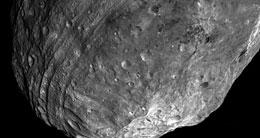Close-up of Vesta poses puzzle
Astronomers keen to look into strange hole on second-largest asteroid.
Published online 12 August 2011 | Nature | doi:10.1038/news.2011.480
 The origin of Vesta's large crater and equatorial ridges is mysterious.NASA/JPL-Caltech/UCLA/MPS/DLR/IDA
The origin of Vesta's large crater and equatorial ridges is mysterious.NASA/JPL-Caltech/UCLA/MPS/DLR/IDAPlanetary scientists thought they knew what to expect when NASA's Dawn spacecraft returned the first close-up portrait of the giant asteroid Vesta last month. Fuzzy images from the Hubble Space Telescope (HST) taken in 1996 seemed to show that something had taken a big bite out of the asteroid's south polar region1.
The crater was posited as the source of Vesta-like fragments that populate the asteroid belt, and of a surprisingly large fraction of the meteorites found on Earth.But seconds after viewing the first image, Peter Thomas of Cornell University in Ithaca, New York, shot off an e-mail to other members of the team: "Looks like HST results were fantasy!"
Thomas later realized he had misjudged Dawn's location when he sent that e-mail, but his words give an idea of scientists' surprise. Vesta's huge depression isn't like those of most impact craters: it is ringed by a wall for only about half its circumference, says Dawn team member Paul Schenk of the Lunar and Planetary Institute in Houston, Texas. It also has a large rounded mound in its middle, rather than the usual conical uplift.
Perhaps strangest of all is a series of troughs ringing the asteroid's equator, a feature not seen in any other body in the Solar System and which may be related to the impact and its huge scale.
If it was caused by an impact, the crater is shaping up to be one of the biggest puzzles of the mission, says Chris Russell, principal investigator of the Dawn mission at the University of California, Los Angeles.
Looking for answers
Russell has commissioned a task force of scientists on the Dawn team to solve the puzzle in time for two conferences in October.New, sharper, images and spectra will help, as will maps of the asteroid's gravity. Dawn is now orbiting Vesta at a distance of about 2,700 kilometres, some six times closer than when the initial observations were made last month.
The task force will use the data gathered from this closer approach to hunt for evidence of whether the hole really was caused by some sort of collision. Tell-tale signs would include rock that has melted and resolidified on the floor of the depression, and a mixture of broken rock and melted material splashed out of the hole by the force of the blow.
Researchers have already come up with several possible explanations for the hole's strange shape. These all assume that the roughly 460-kilometre-wide crater was gouged out by a piece of space debris measuring 40-80 kilometres across.
One idea is that Vesta, which, at 530 kilometres across is the second-largest asteroid in the Solar System, was struck not at its south pole but midway between the pole and the equator. Because it spins rapidly, completing a full rotation in about five hours, Vesta would have reoriented itself so that the gouged-out region became the rock's new south pole.
This would be the most stable configuration for the damaged asteroid, says Schenk. "I don't think we've ever seen before a body with such a large impact and such a high rotation rate," he says.
In January, Martin Jutzi of the University of Bern in Switzerland and Erik Asphaug of the University of California, Santa Cruz, modelled the impact that walloped Vesta and obtained some surprising results2.
They calculate that Vesta completed an entire revolution while the crater was forming. As a result, the debris thrown up by the impact did not settle evenly around the crater, but fell in uneven clumps. This lopsided excavation might explain why a wall runs around only half of the impact site.Russell is also hoping that Dawn will explain why Vesta is the brightest member of the asteroid belt, reflecting some 40% of the sunlight that hits it.
Images from the craft have already showed that some regions of the asteroid are brighter than average, and revealed dark streaks on the inside of craters. Compositional information recorded by Dawn's spectrometers may also show whether the bright regions are made from different material or whether they simply have a more crystalline structure, which scatters more light, Russell says.